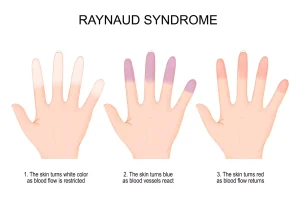From fingers to toes, the color of your skin can shift dramatically during freezing weather. Like many, you might have been alarmed the first time you noticed it. But over time, people often accept it as normal.
The truth is, this color change – from your usual tone to pale white or dark red – could be due to a condition known as Raynaud’s disease.

What is Raynaud’s disease?
Raynaud’s disease, or Raynaud’s phenomenon, affects how your body reacts to cold temperatures. It’s not just about feeling cold – the changes in color and temperature can be much more intense.
Dr. Melisa Lai Becker explained to Good Morning America:
“For most people, chilly weather might make their fingers cold, but with Raynaud’s, the hands can turn ice-cold and visibly change color.”
The condition happens when blood flow to your fingers and toes is reduced. According to the NHS, it’s fairly common and usually doesn’t cause major issues, but it can still be uncomfortable.

Symptoms of Raynaud’s disease
Raynaud’s often occurs when you’re cold, stressed, or anxious. Common symptoms include:
- Color changes in fingers or toes (white, blue, or red).
- Pain in affected areas.
- Numbness or a tingling feeling, like pins and needles.
In some cases, these symptoms may also appear in places like the ears, lips, nose, or even nipples.

When to see a doctor
Dr. Lai Becker advises seeing a doctor if symptoms last a long time or cause severe pain that makes daily tasks difficult.
Raynaud’s can sometimes be linked to other health problems or medications, which a doctor can help identify.
The condition is more common in women and is often first noticed during teenage years. It’s estimated that up to 20% of adults worldwide have Raynaud’s.
If you’re noticing these symptoms, it’s a good idea to consult with a doctor for advice and possible treatment.





